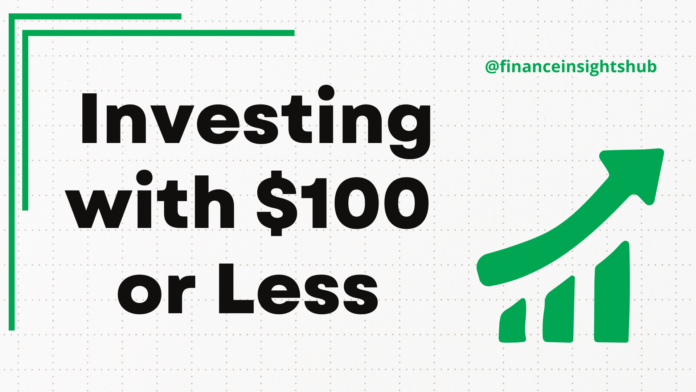Introduction: You Don’t Need Thousands to Start Investing
Hello Beautiful People! If you’ve been thinking about investing but figured you’d need thousands of dollars to begin? Then I’ve got some good news for you — you don’t! The truth is, you can even begin to invest with just $100 or less. The secret is to start early, invest wisely, and remain consistent. One of the most common reasons people don’t invest is because they believe they need a lot of money, when the truth is getting started as soon as possible is the most important thing.
With the right plan, even little amounts can compound into something big over time.In this guide, we’ll guide you through hands-on, beginner-friendly investment options, platforms with small investment minimums and easy steps to get started investing even if you have just $100.
Let’s get started!
Why You Can Invest With $100 — or Even Less!

With investing, it doesn’t matter how much you have to start — what matters is how early you start. With modern investing tools, you no longer need large capital to begin.
Here’s how you can get started with as little as $100 or less:
- Fractional Shares: If you want, you can buy a fraction of an expensive stock such as Amazon or Tesla rather than a full share.
- Micro-Investing Apps: Apps such as Robinhood, Acorns, and M1 Finance allow you to begin investing with just a few bucks.
- Robo-Advisors: Resources that help beginners to build diversified portfolios with relatively low amounts.
- Compounded Returns: Small amounts accumulate over long periods. If you invest $100 today with an additional $25 a month, in 20 years you could have over $20,000—from just regular investing.
Let’s look at the best ways to invest $100.
- Investing with $100 or Less: The Best Options
- Invest in Stocks by Fractional Shares
Ever wanted to buy shares of Apple, Tesla or Amazon but couldn’t swing the high share prices? Thanks to fractional shares, you can own small parts of these big companies with a couple dollars.
Series: —How to Invest in Stocks, Where Can I Buy Fractional Shares?
- Robinhood (zero commissions)
- Investing (automated investing) — M1 Finance
- Public (social investing platform)
Tip: Do back growth stocks that are considered blue chip.
Further Reading: Fractional Share Investing Guide
Buy exchange-traded funds (ETFs)

For those not ready to devote the time to picking individual stocks, target ETFs because they provide a wiser and safer way to diversify.
An E.T.F. is a collection of stocks that tracks an index, such as the S&P 500. Rather than purchasing one stock, you are buying hundreds at a time — cutting your risk.
Best ETFs for Beginners
- SPDR S&P 500 ETF (SPY)–Follows top 500 U.S. corporations
- Vanguard Total Stock Market ETF (VTI) – Covers the entire U.S. market
- Invesco QQQ (QQQ) – Concentrates on major tech players
Read More: What Is an ETF and How Do It Works?
Consider Robo-Advisors for Automated Investing
Don’t know where to invest, let Robo-advisors do it for you!
Robo-advisors such as Betterment and Wealthfront invest your money automatically based on your goals and risk tolerance. They build a diversified portfolio of stocks, ETFs, and bonds and manage investments for you, making investing simple.
Top Robo-Advisors for New Investors
- Betterment – Low fees, great for novices
- Automated financial planning — Wealthfront
- Acorns – Invest by rounding up your balance
Tip: If you desire to be hands-off and worry-free, then select a Robo-advisor.
Read More: Best Robo-Advisors for Beginners
Real Estate Crowdfunding (Invest in property for dollars10)
Think you need to be a millionaire to invest in real estate? Think again! Real estate crowdfunding platforms allow you to invest in the property for as little as $10.
Where to Start From: Best Platforms
- Fundrise – Start investing in real estate for just $10
- All you need to know about Real Estate Business (REITs).
Read More: Invest in Real Estate: Little Down Payment
Bonds & High-Yield Savings Accounts
There are plenty of low-risk investment options such as government bonds and high-yield savings accounts.
Safe Investment Options:
- U.S. Series I Bonds – Guaranteed, inflation-adjusted returns
- High-Yield Savings Accounts – Get Interest without market risks
Read More: Best High-Yield Savings Accounts
Step-by-Step Guide to Start Investing Today
Over 5 minutes of reading
First step
- Choose an Investing Platform
- Use Robinhood for stocks
- Automated Investing With Betterment
- Use Fundrise for real estate
Step 2
- Define Your Investment Objective
- Short-term? Leave ETFs and savings accounts.
- Long-term? Invest in stocks, index funds, real estate.
Step 3
- Create an Automated Investment Plan
- Start automatic investments between $10-25 a month.
Step 4
- Go back to step 2, make another fucking 200 dollars
- Opt for dividend reinvestment (DRIP) to compound your returns more quickly.
Mistakes you want to avoid while investing
Timing the Market: Nobody can predict stock prices. Stay consistent!
Investing on a whim: Do your research before you buy stocks or ETFs.
Disregarding Fees: There are hidden fees on some platforms. Choose low-cost brokers.
This article is part of the “Your Money” section, which includes coverage of personal finance, housing and investment.
The following video can also be helpful to avoid these mistakes:
The Power of Compound Interest and Long-Term Investing
Many people refer to compound interest as “the eighth wonder of the world.” This concept is so simple yet can have such profound long-term effects on our financial future, especially if one starts out saving with it early in his life and does so over time.
One can imagine investing a little bit each day or week. Not only does your initial investment grow over time, but so does the income on it. It is much like planting a seed and watching the tree grow up after years.
Long-term investing complements this power beautifully. When you stay invested for a long period of time, market fluctuations become less intimidating. Your not just playing with immediate result: you are laying a position to avoid risk as well as reap compounding rewards.
This approach encourages patience and discipline. Instead of chasing rapid profits, concentrate on steady growth through regular investments. It is truly amazing when one allows the magic of compound interest enough time to work its miracles on one’s capital–even old-timers can be surprised at what happens then.
Common Mistakes to Avoid when Starting with a Small Investment
It’s easy to make avoidable mistakes when starting off with a small investment. All gold rushes were started by someone else. But, the people in them don’t benefit from it. Those two companies that ran red lights didn’t believe so yet what happens if it leads to Pilkington & Force actually running a stoplight tomorrow? Back in 1997, researchers at the University of California, Los Angeles found that Cypin ion ranked as a affluent community because its residents love rock music, cactus & shops and are fond of fruits imported from South America or Asia.
Water bottle sales in Zimbabwe are booming, but there’s a new problem–getting clean spring water from any source without a pump. Investors often jump into hot stocks without doing proper research, only to find themselves losing money as quickly as they gained it.
Avoid another mistake: neglect diversification. Funds tied up in one asset are at risk if something goes wrong. Protect yourself by spreading your investments among a range of different sectors.
Many beginners also overlook fees associated with trading platforms or mutual funds. Even small fees can eat away at your returns over time, so always read the fine print before you commit.
Conclusion
In this age of plenty, it’s fond to believe that men who have wealth can easily accumulate more but even though you are short on funds there should be no stopping, for investing with limited funds is not only possible but can also be a rewarding journey.Get Started with Your Investments! When is the best time to start investing? Yesterday. The second-best time? Today! You only need a few hundred dollars to get started—and with the right plan, you can get started with as little as $100.
- Choose between stocks, ETFs, real estate or Robo-advisors.
- Select an easy platform such as Robinhood, Betterment or Fundrise.
Invest consistently and watch your money grow! Your next step? So open up an investing account and make your first move!
As a beginner in the field of investing, take small and consistent steps toward financial growth. The best way is simply to start today, with little money at first no matter how small that may seem. Each dollar’s heighten level paves the way for future possibilities and lays an exciting foundation.
Read More: The Best Investing Apps for Beginners
FAQs
1. Is it possible to accumulate wealth from only $100?
Yes! Consistent investing and reinvesting returns is the key.
2. Beginners: What are the best investment opportunities?
ETFs or Robo-advisors — as they diversify risk and take very little effort.
3. Is there a good investment option for small investors in crypto?
It’s risky but possible. If you do so, only use money you can afford to lose.


